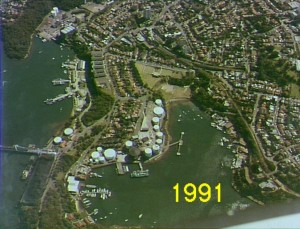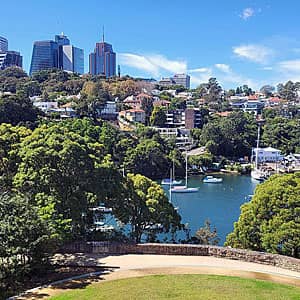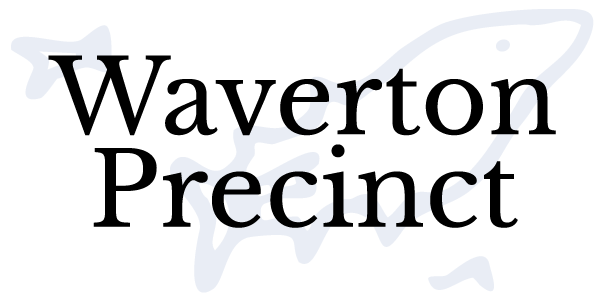Historical Campaigns
Past Campaigns
The creation of Carradah Park – 2000s
 As today’s residents and visitors enjoy Waverton’s vistas across the harbour and pleasant walking areas in large numbers, it can be hard to recall the highly industrialised nature of Sydney Harbour in decades past. And even harder to imagine the difficult fight it took for local residents to save these places for public amenity.
As today’s residents and visitors enjoy Waverton’s vistas across the harbour and pleasant walking areas in large numbers, it can be hard to recall the highly industrialised nature of Sydney Harbour in decades past. And even harder to imagine the difficult fight it took for local residents to save these places for public amenity.
The area around Berrys Bay that we now enjoy as Carradah Park would have been first occupied by the Cammeraygal people. The first recorded occupation of the area by Europeans was in 1825 when Edward Wollstonecraft acquired a grant of 524 acres of land. The site was leased to the Anglo-Persian Oil Company Ltd (the predecessor of BP) in 1920, and the first storage tank was built around 1923, despite strong resident opposition at the time.
Massive tanks were built right into the sandstone to the east of Larkin Street for the storage and distribution of oil and petrol from tankers that docked at the nearby wharf.
The area was declared contaminated in 1980 but did not fully close until 1993. It was another four years before a clean up of the site commenced – a process in which the tanks were finally removed from the area.
Almost immediately, the community’s vision of finally creating a public parkland on this special site with clear vistas to the Harbour Bridge was countered by developers who proposed the eastern side of Larkin Street to feature a row of high level terrace houses.
Local residents of Waverton fought strongly for the return of this area to public ownership and amenity. Working closely with North Sydney Council, residents campaigned loudly and publicly through events such as public rallies around Waverton Station as well as other actions to ensure this area did not become an enclave for a few but an open space for everyone.
In 1997, the then NSW Premier Bob Carr personally visited the area and announced that this site, together with the Coal Loader and Caltex Sites on the western side of the Waverton peninsula, would be preserved as Public Open Space.
A Strategic Master Plan for the sites was completed in 1999, and construction of the newly-designed park lands was completed in 2005 – some 8 years after Mr Carr’s visit.
Carradah Park is named after the Cammeraygal man, Carradah, who befriended Lieutenant Henry Lidgbird Ball, the Commander of the First Fleet’s HMS Supply, and after whom nearby Balls Head was named in the 1790s. Carradah reportedly adopted Ball’s surname as a sign of respect. He was one of the few Cammeraygal people specifically named in the early colonial accounts.
What happens when the oil tankers decide to leave? The fight for Carradah Park

Today, Carradah Park is used by Waverton locals and visitors to the area, being accessible by train, bus and car. It features open parkland with spectacular views across the Harbour, native vegetation, walking trails, stairways with natural surfaces that work harmoniously with nearby Balls Head Reserve. Rather than denying Waverton’s industrial heritage, the design of the park echoes it, providing a unique character among Sydney harbour parklands.
Carradah Park is both steep and rocky, yet easily accessible due to its considered design features. Balls Head Reserve, located a short stroll away, offers a calming oasis but Carradah Park places one right in the thick of the city, with attractive views across to the Harbour Bridge, the Opera House and the city skyline.
Large Marina for Berrys Bay & Balls Head
When thinking of Waverton, the trees and beautiful vistas to be found at Balls Head Reserve are inevitably the first images that come into many people’s minds. An oasis so close to the City is highly prized by all.
But at one point, the very existence of the natural character of this area was under threat.
In the early 2000s, discussions about extending the small marina in Berrys Bay soon became a plan for a much larger marina on the cards. Developers and residents who wished to retain public access and quiet amenity of this area were at logger heads.
Between c.2006 and 2017, the marina future was actively debated between residents and the Premier of NSW, Gladys Berejiklian. The proposed marina would fill the western arm of the bay. A meeting was arranged at the end of Larkin Street where residents met with the Premier. She saw the merits of a quiet bay close ot the Sydney Harbour Bridge. This terminated the quest for a Marina, and in 2022, the new Premier Dom Perrottet announced a new park would be created. Unfortunately the solution did not expand to the clean up of the bay, and that still remains an issue for the Precinct.
Navy Car Park
On Balls Head Road, NSW TAFE owned extensive pre-fab buildings at the end of their useful life. In the 1960s these were finally taken down. The Australian Navy wanted to replace these with an extension of their nearby base and construct a 2 or 3 storey military training facility. The Precinct led a public outcry for such a construction on an iconic site. A settlement was reached in that the building was not erected, but the site turned into a car park for Navy personnel. While the public can still view the harbour from the public footpath, it was seen by the Precinct and residents as a compromise as it could not be included in the public space that could have wrapped around the peninsula.
This campaign took decades to resolve, having started in the 1960s with the removal of the TAFE buildings to the final, current agreement for the usage of the site as a car park in 2006.
